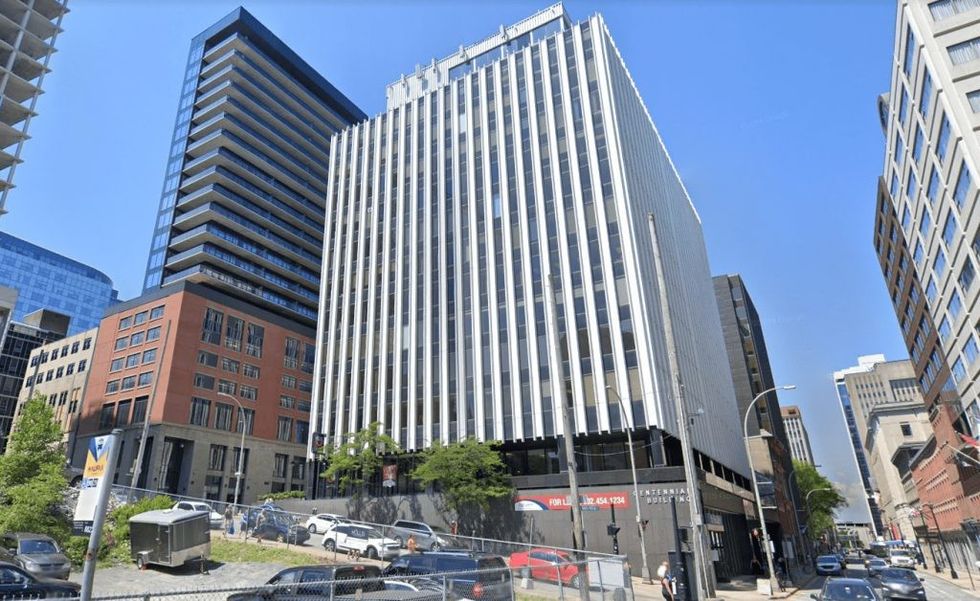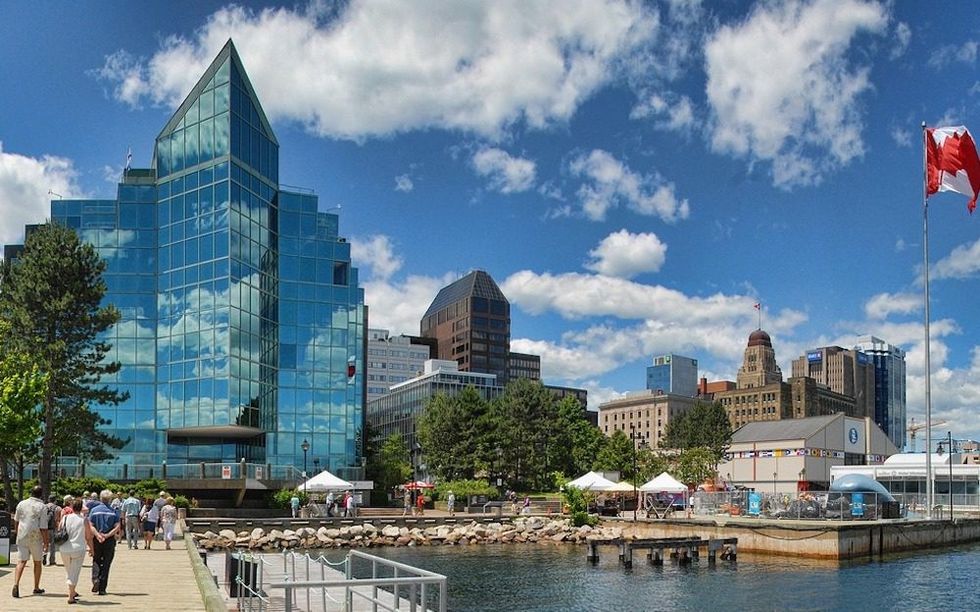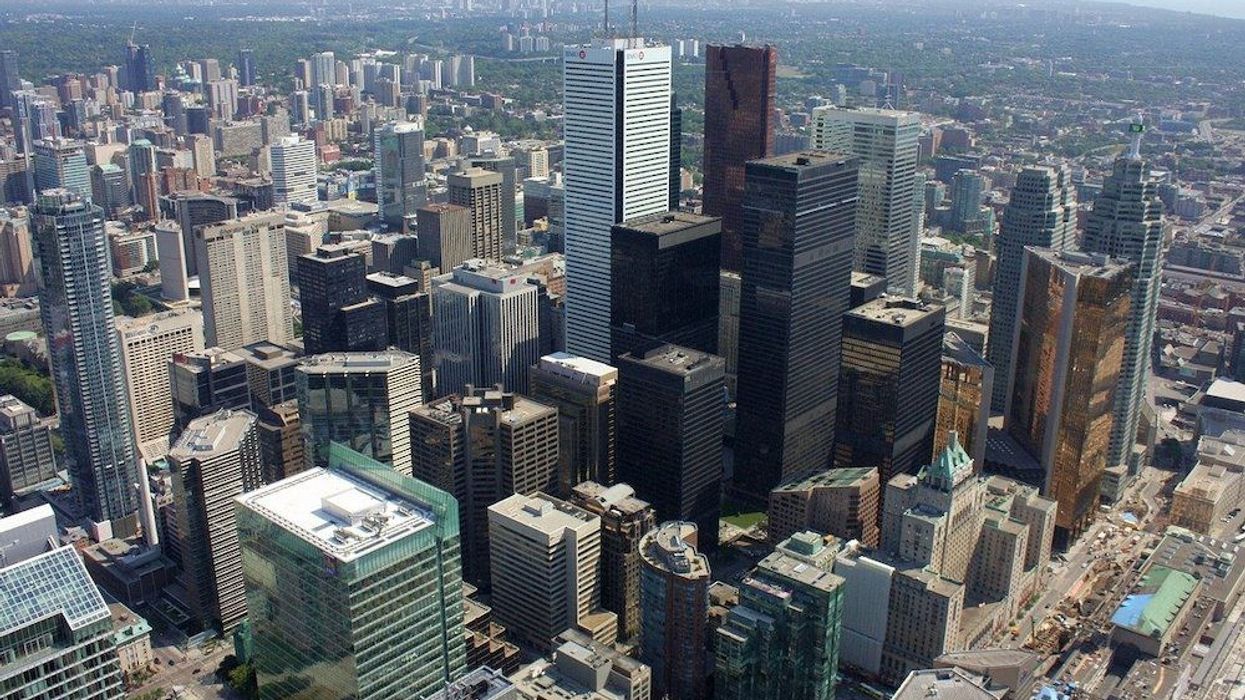A dated office building in downtown Halifax will get a new lease on life with a transformation that will turn it into a mixed-use building with an affordable(ish) housing component.
Adding relief to the city's housing supply crisis, half of the Centennial Building -- a 54-year-old office tower at 1660 Hollis Street -- will be renovated into one, two, and three-bedroom industrial-feeling loft apartments.
Rent in 38 of the 100 units will be subsidized by the province of Nova Scotia.
The buzzed-about project is slated for completion mid-2023 (permit depending, naturally) and was one of three announced last month as recipients of more than $6M to partially subsidize rents on some units. As part of a $1.9 million deal with the province, Sidewalk Real Estate Development will rent these units for the first 20 years at least 20% below the average rate reported by the Canadian Mortgage and Housing Corporation (CMHC).

“Our goal is to create a true mixed-use building; we’ll keep some floors offices with some existing tenants remaining, and the other half of the building will become residences,” says Joe Nickerson, vice president of Sidewalk Real Estate Development.
“The residential component we’re looking to deliver is more of a hard loft look, which isn’t as common in Halifax as it is in Toronto. So, we’re looking to do something in the vein of Toronto’s Tip Top Lofts: exposed concrete ceilings, polished concrete floors, loft-style windows, and much more of a gritty loft feel than a polished new-build condo.”
There will be no difference design-wise between the more affordable units and the 62 market-priced units, says Nickerson.
Given the prime piece of downtown real estate and the fact that just 20% of the market priced rent will be subsidized, it’s not surprising that Nickerson says the units aren’t intended to house the city’s most economically vulnerable in the form of ultra-low-income housing. But its lower cost options will undoubtedly offer relief to some in a climate of climbing rent prices.
“I think it will be a true eclectic mix,” says Nickerson of the future residents with subsidized rents. “We’re going with more of an art focus with the branding and the design of the buildings. So, it will likely house students, recent grads, artists, and workers at nearby bars and restaurants -- people that keep the vibrant nature of downtown Halifax.”
Nickerson points to the close proximity of Nova Scotia College of Art and Design (NSCAD) in discussing the building’s appeal to everyone from first-year students to recent grads.
“The remaining units -- the bulk of the units -- will be marketed to 30-plus, more established renters looking for a unique loft product instead of a very modern new condo feel,” says Nickerson. “The per-square-foot rents surrounding us are the highest in the city, and they are brand new condos, so we are looking to differentiate with art, creativity, and a more of a loft style.”
Nickerson says about 30% of the building was vacant at time of purchase earlier this year, but the rate will likely increase when leases expire. While the pandemic-inspired work-from-home culture may have compounded an exodus from the building’s office spaces, Nickerson says the Centennial Building was losing commercial tenants before the onset of the pandemic and its shake-up of "business as usual."
And the building's story isn’t unique to the Maritime city.
“Halifax office space has a higher vacancy rate for the past few years in the B-class office space -- particularly, the B- class older office product space,” says Nickerson. “The building has a core contingent of government-style leasing companies; it has everything from architectural firms to the PC party and other government entities. It’s traditionally been a government-style office building. So, there wasn’t a ton of cosmetic upgrades to the common areas prior.”
As a result of the outdated aesthetics, says Nickerson, tenants looking for more A-class office space relocated to shiny new spots. Over the past five years especially in Halifax, he says, a large supply of brand-new office space also hit the market, adding further incentive to upgrade.

In a climate of a newfound remote work culture and relentless housing supply crisis, converting office buildings -- or, at least, parts of office buildings -- into housing seems like a solution worthy of consideration. After all, many of these buildings have sat vacant for almost two years now, all while the housing affordability crisis has gotten increasingly worse across the country.
Toronto currently has an office vacancy rate of 15%, up from 9.4% pre-pandemic. Here, the city's empty office buildings (whether temporarily abandoned as the pandemic rages on, or done away with for good once leases expired) are a stark juxtaposition to the rapidly growing number of homeless residents that sleep outside their facades each night.
While the conversion from office buildings to housing sounds like a nice idea in theory, the reality is that structural concerns and an abundance of red tape for many buildings render such a conversion out of the question for developers. A conversion of older city office buildings to residential structures involves many building code, site, and elevator issues to navigate. Even things like lack of balconies are of concern.
“It’s really a matter of existing structure; whether or not it’s cost effective to convert the structure to other type of uses like apartments, or to tear the buildings down and start from scratch because you don’t have to deal with the mechanics and pipes,” says Ray Wong, vice president of Altus Group, a data solutions firm for the real estate industry. “The ability to convert to other uses really depends on the buildings and the cost to renovate it, and as well as whether it can reach the market rents to justify that type of investment.”
Nickerson agrees that “there are so many things that have to work” for a large-scale building conversion to be a viable option.
In the case of the Centennial Building, the building was built in two phases, so there are two separate elevator banks – a bank of two and a bank of three, in completely separate parts of the building. “So, to say we’re going to split the building in half and dedicate half the building to office and half to residential is rare,” says Nickerson. “There are very few buildings that will have completely separate entrances and elevator banks built into the building like we have.”
Furthermore, the Centennial Building has good bones. While the aesthetics of the building may have been stuck in the past, all of the mechanical systems that would be typical of an office building are up-to-date; the elevators were modernized in 2019 and the guts of the building are fairly new, according to Nickerson.
But that’s not the case for many office buildings throughout the country. Realistically, office-to-home conversions only work for a select few buildings in a select few markets, says Nickerson. “I think it will become more common in some markets than in the past, because it essentially wasn’t happening at all,” he says of the office-to-residence conversion. “But I think it’s a building-by-building, case-by-case type of scenario."
Wong agrees that conversions like the Centennial Building's likely won’t become the norm -- like the conversion of factories into housing, for example -- in addressing housing supply issues. “We may see one or two similar initiatives in Halifax, or office space knockdowns, but it really depends on the existing property structure and the rents,” says Wong. He points to the fact that the Centennial Building has it a little easier cost-wise, thanks to the funding from the province.
“Calgary is going through the exercise of trying to find any aging office buildings that can be converted into housing, but the actual cost and infrastructure to make that conversion -- it’s costly without a top-up, help, or subsidies from the government,” says Wong.
While the City of Calgary announced earlier this year that it will grant the owners of downtown office buildings $75 per square foot -- up to a maximum of $10 million per property -- to convert them to residential, critics say this will fund few buildings and question whether the incentive is there for developers.

While a remote work culture has become the norm, forever changing the structure of some organizations in the process, is it premature to assume that the empty office spaces -- in aging buildings or not -- will remain empty and undesired once the pandemic (finally) becomes a distant memory?
While he anticipates a hybrid work culture once the pandemic subsides, Wong says it's still too early to predict the fate of the office building. “I think it will be another 12 to 18 months for us to really see the impact on the office market, and whether we will see a higher vacancy rate on the older office buildings that will create opportunities for apartments,” says Wong.
While the uncertainty around the fate of Canada’s office spaces remains, there’s one thing that remains crystal-clear: there’s a housing supply crisis across the country that’s left no city untouched.
Whatever we can do to alleviate some pressure and bring housing supply onto the market -- whether it involves turning offices into homes in Halifax, or a speculation tax in Toronto -- should be on the table.





















